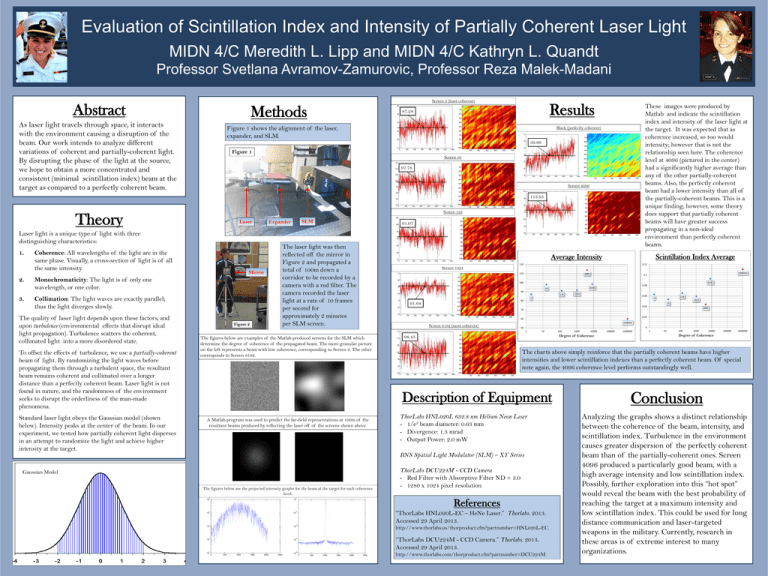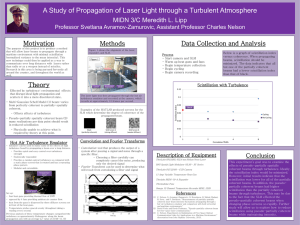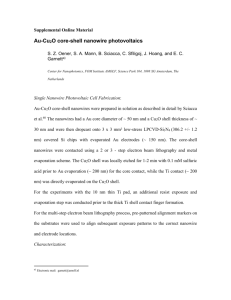Evaluation of Scintillation Index and Intensity of Partially Coherent Laser... Results Abstract Methods
advertisement

Evaluation of Scintillation Index and Intensity of Partially Coherent Laser Light MIDN 4/C Meredith L. Lipp and MIDN 4/C Kathryn L. Quandt Professor Svetlana Avramov-Zamurovic, Professor Reza Malek-Madani Screen 2 (least coherent) Abstract Methods As laser light travels through space, it interacts with the environment causing a disruption of the beam. Our work intends to analyze different variations of coherent and partially-coherent light. By disrupting the phase of the light at the source, we hope to obtain a more concentrated and consistent (minimal scintillation index) beam at the target as compared to a perfectly coherent beam. These images were produced by Matlab and indicate the scintillation index and intensity of the laser light at the target. It was expected that as coherence increased, so too would intensity; however that is not the relationship seen here. The coherence level at 4096 (pictured in the center) had a significantly higher average than any of the other partially-coherent beams. Also, the perfectly coherent beam had a lower intensity than all of the partially-coherent beams. This is a unique finding; however, some theory does support that partially coherent beams will have greater success propagating in a non-ideal environment than perfectly coherent beams. Results 87.28 Figure 1 shows the alignment of the laser, expander, and SLM. Black (perfectly coherent) 59.86 Figure 1 Screen 16 97.78 Screen 4096 113.95 Screen 128 Theory Laser Laser light is a unique type of light with three distinguishing characteristics: 1. 2. 3. Coherence: All wavelengths of the light are in the same phase. Visually, a cross-section of light is of all the same intensity. Mirror Collimation: The light waves are exactly parallel; thus the light diverges slowly. To offset the effects of turbulence, we use a partially-coherent beam of light. By randomizing the light waves before propagating them through a turbulent space, the resultant beam remains coherent and collimated over a longer distance than a perfectly coherent beam. Laser light is not found in nature, and the randomness of the environment seeks to disrupt the orderliness of the man-made phenomena. Standard laser light obeys the Gaussian model (shown below). Intensity peaks at the center of the beam. In our experiment, we tested how partially coherent light disperses in an attempt to randomize the light and achieve higher intensity at the target. 91.07 The laser light was then reflected off the mirror in Figure 2 and propagated a total of 100m down a corridor to be recorded by a camera with a red filter. The camera recorded the laser light at a rate of 10 frames per second for approximately 2 minutes per SLM screen. Monochromaticity: The light is of only one wavelength, or one color. The quality of laser light depends upon these factors, and upon turbulence (environmental effects that disrupt ideal light propagation). Turbulence scatters the coherent, collimated light into a more disordered state. SLM Expander Figure 2 Screen 1024 0.12 120 110 4096 8192 90 128 0.04 Screen 8192 (most coherent) 0 1000000 0 50 10 -10 ThorLabs HNL020L 632.8 nm Helium Neon Laser - 1/e2 beam diameter: 0.63 mm - Divergence: 1.3 mrad - Output Power: 2.0 mW “ThorLabs DCU224M - CCD Camera.” Thorlabs. 2013. Accessed 29 April 2013. -15 10 -4 10 -20 0 500 1000 1500 2000 2500 10 ThorLabs DCU224M - CCD Camera - Red Filter with Absorptive Filter ND = 3.0 - 1280 x 1024 pixel resolution http://www.thorlabs.us/thorproduct.cfm?partnumber=HNL020L-EC. 10 0 500 1000 1500 2000 2500 1000 10000 100000 1000000 1 10 100 1000 10000 100000 1000000 Degree of Coherence The charts above simply reinforce that the partially coherent beams have higher intensities and lower scintillation indexes than a perfectly coherent beam. Of special note again, the 4096 coherence level performs outstandingly well. “ThorLabs HNL020L-EC – HeNe Laser.” Thorlabs. 2013. Accessed 29 April 2013. -5 10 100 Degree of Coherence 98.45 References 10 -3 4096 0.02 60 The figures below are the projected intensity graphs for the beam at the target for each coherence level. 10 1024 70 Gaussian Model -2 128 2 16 BNS Spatial Light Modulator (SLM) – XY Series 10 0.06 80 91.64 A Matlab program was used to predict the far-field representations at 100m of the resultant beams produced by reflecting the laser off of the screens shown above. -1 1024 2 Description of Equipment 10 0.08 8192 16 The figures below are examples of the Matlab produced screens for the SLM which determine the degree of coherence of the propagated beam. The more granular picture on the left represents a beam with low coherence, corresponding to Screen 2. The other corresponds to Screen 8192. 0 1000000 0.1 100 1 10 Scintillation Index Average Average Intensity http://www.thorlabs.com/thorproduct.cfm?partnumber=DCU224M. Conclusion Analyzing the graphs shows a distinct relationship between the coherence of the beam, intensity, and scintillation index. Turbulence in the environment causes greater dispersion of the perfectly coherent beam than of the partially-coherent ones. Screen 4096 produced a particularly good beam, with a high average intensity and low scintillation index. Possibly, further exploration into this “hot spot” would reveal the beam with the best probability of reaching the target at a maximum intensity and low scintillation index. This could be used for long distance communication and laser-targeted weapons in the military. Currently, research in these areas is of extreme interest to many organizations.





